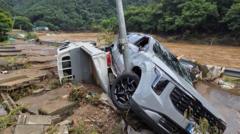How Did Recent Floods and Landslides in South Korea Claim 14 Lives?

Understanding the Impact of Floods and Landslides in South Korea
In recent days, South Korea has been grappling with the devastating effects of torrential rain that has resulted in catastrophic floods and landslides. The country's disaster management office has confirmed that at least 14 lives have been lost due to these weather-related incidents, with the death toll expected to rise as rescue operations continue. With nearly 10,000 individuals having evacuated their homes and over 41,000 households losing power, the situation remains dire. The rain has largely subsided in the most affected southern and central regions, but forecasts indicate that more rainfall is expected in the capital, Seoul, and other northern areas. This article explores the causes, effects, and the ongoing recovery efforts in response to this natural disaster.
The Causes of Flooding and Landslides
Understanding the factors that contribute to flooding and landslides is essential in addressing the aftermath of such disasters. Several reasons explain the recent floods in South Korea:
- Torrential Rainfall: The primary cause of the floods has been the unprecedented amount of rainfall, which began on a Wednesday and continued for several days. Such continuous and heavy precipitation saturates the ground, leading to water overflow.
- Geographical Factors: South Korea's mountainous terrain makes it particularly vulnerable to landslides. When the soil becomes too saturated, it can no longer support the weight of the earth above it, leading to landslides.
- Climate Change: Experts suggest that climate change is contributing to more extreme weather patterns, including heavier rainfall events, which can exacerbate flooding and landslide risks.
- Urbanization: Rapid urbanization has led to increased impervious surfaces in cities, preventing water from being absorbed into the ground and increasing the chances of flooding.
Immediate Effects of the Disaster
The immediate impacts of the recent floods and landslides have been severe and multifaceted:
- Loss of Life: Tragically, the disaster has claimed at least 14 lives, with ongoing rescue operations raising concerns that the toll could increase. Twelve individuals remain unaccounted for.
- Displacement: Almost 10,000 people have been forced to evacuate their homes for safety, highlighting the urgent need for emergency shelters and resources.
- Infrastructure Damage: Thousands of roads and buildings have been damaged or submerged, hampering rescue efforts and creating challenges for recovery.
- Power Outages: Over 41,000 households have temporarily lost power, which complicates communication and relief efforts.
- Agricultural Impact: The floods have damaged farmland significantly, raising concerns about food security and economic recovery in the agricultural sector.
Rescue and Recovery Efforts
In response to the disaster, the South Korean government has initiated a multi-agency recovery effort to address the immediate needs and long-term recovery of affected communities. Here are some key aspects of the response:
- Search and Rescue Operations: Emergency services are actively searching for missing individuals while assessing the damage to provide assistance to those in need.
- Emergency Shelters: Temporary shelters have been established to accommodate displaced individuals, providing them with food, medical care, and psychological support.
- Infrastructure Repair: Efforts to repair damaged infrastructure, including roads and utilities, are underway to restore normalcy and access to affected areas.
- Long-term Planning: Authorities are also focusing on long-term strategies to enhance flood management systems and improve disaster preparedness to prevent future occurrences.
The Role of Community Resilience
Communities play a crucial role in disaster recovery, and South Korea is no exception. Local organizations and volunteers are stepping up to assist with relief efforts. Here are ways communities are contributing:
- Volunteer Support: Many citizens are volunteering to help with search and rescue operations, offer food and shelter, and provide comfort to those affected.
- Donations: Individuals and businesses are donating essential supplies, such as food, clothing, and hygiene products, to support evacuation centers.
- Awareness Campaigns: Community leaders are organizing campaigns to educate residents about disaster preparedness, ensuring that they are better equipped to handle future emergencies.
Future Preparedness and Mitigation Strategies
As South Korea recovers from this devastating disaster, it is essential to focus on future preparedness and mitigation strategies to minimize the impact of similar events. Some approaches include:
- Improved Infrastructure: Investing in flood-resistant infrastructure, such as upgraded drainage systems and flood barriers, can help manage heavy rainfall in the future.
- Early Warning Systems: Enhancing weather forecasting and early warning systems can provide timely alerts to communities, allowing them to prepare and evacuate if necessary.
- Environmental Restoration: Restoring natural landscapes, such as wetlands and forests, can help absorb excess rainwater and reduce the risk of flooding.
- Community Training Programs: Implementing training programs for emergency responders and community members can ensure a coordinated and effective response during emergencies.
FAQs
What should I do during a flood warning?
During a flood warning, it is crucial to stay informed through local news and alerts, evacuate if advised, and avoid driving through flooded areas. Prepare an emergency kit with essentials and seek higher ground if necessary.
How can communities prepare for future floods?
Communities can prepare for future floods by developing emergency plans, conducting drills, investing in resilient infrastructure, and promoting awareness about flood risks and preparation strategies.
What are the long-term effects of floods on agriculture?
Floods can lead to soil erosion, crop damage, and loss of livestock, affecting food security and farmers' livelihoods. Long-term recovery may involve replanting crops and restoring soil health.
How do landslides occur during heavy rainfall?
Landslides often occur when heavy rainfall saturates the soil, causing it to lose stability and slide down slopes. Factors like steep terrain and human activities can exacerbate this risk.
What support is available for those affected by floods?
Support for those affected by floods typically includes emergency shelters, food and medical assistance, financial aid, and mental health resources provided by government agencies and non-profit organizations.
The recent floods and landslides in South Korea illustrate the devastating power of nature and the importance of preparedness and resilience in the face of such disasters. As recovery efforts continue, it’s crucial for individuals and communities to reflect on lessons learned and consider how they can better prepare for future events. What steps do you think are necessary to enhance disaster preparedness in your community? #Floods #DisasterRecovery #ClimateChange
Published: 2025-07-20 07:36:02 | Category: world



